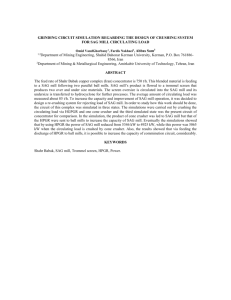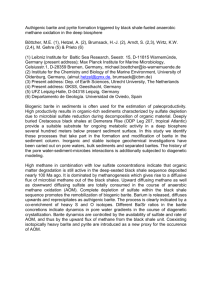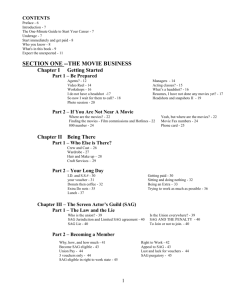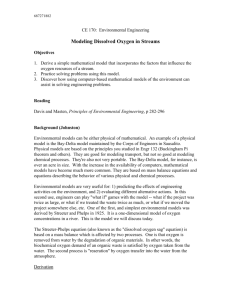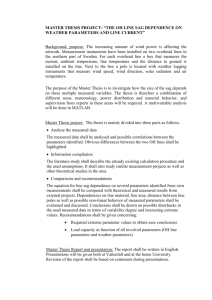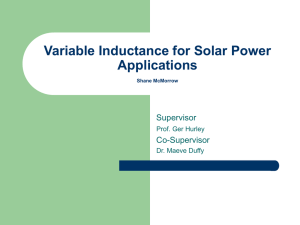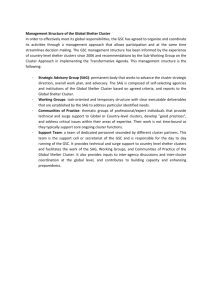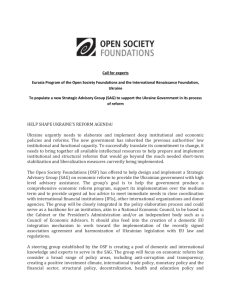Comparisons of Barite Sag Measurement and Numerical Prediction
advertisement
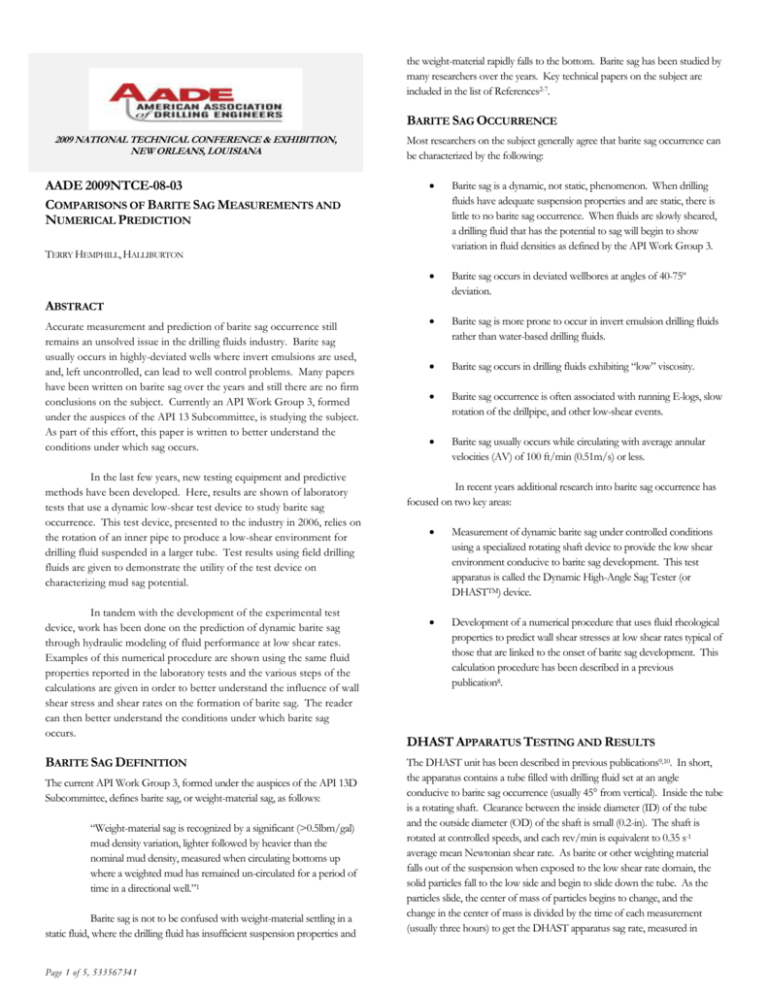
the weight-material rapidly falls to the bottom. Barite sag has been studied by many researchers over the years. Key technical papers on the subject are included in the list of References2-7. BARITE SAG OCCURRENCE 2009 NATIONAL TECHNICAL CONFERENCE & EXHIBITION, NEW ORLEANS, LOUISIANA AADE 2009NTCE-08-03 COMPARISONS OF BARITE SAG MEASUREMENTS AND NUMERICAL PREDICTION Most researchers on the subject generally agree that barite sag occurrence can be characterized by the following: Barite sag is a dynamic, not static, phenomenon. When drilling fluids have adequate suspension properties and are static, there is little to no barite sag occurrence. When fluids are slowly sheared, a drilling fluid that has the potential to sag will begin to show variation in fluid densities as defined by the API Work Group 3. Barite sag occurs in deviated wellbores at angles of 40-75º deviation. Barite sag is more prone to occur in invert emulsion drilling fluids rather than water-based drilling fluids. Barite sag occurs in drilling fluids exhibiting “low” viscosity. Barite sag occurrence is often associated with running E-logs, slow rotation of the drillpipe, and other low-shear events. Barite sag usually occurs while circulating with average annular velocities (AV) of 100 ft/min (0.51m/s) or less. TERRY HEMPHILL, HALLIBURTON ABSTRACT Accurate measurement and prediction of barite sag occurrence still remains an unsolved issue in the drilling fluids industry. Barite sag usually occurs in highly-deviated wells where invert emulsions are used, and, left uncontrolled, can lead to well control problems. Many papers have been written on barite sag over the years and still there are no firm conclusions on the subject. Currently an API Work Group 3, formed under the auspices of the API 13 Subcommittee, is studying the subject. As part of this effort, this paper is written to better understand the conditions under which sag occurs. In the last few years, new testing equipment and predictive methods have been developed. Here, results are shown of laboratory tests that use a dynamic low-shear test device to study barite sag occurrence. This test device, presented to the industry in 2006, relies on the rotation of an inner pipe to produce a low-shear environment for drilling fluid suspended in a larger tube. Test results using field drilling fluids are given to demonstrate the utility of the test device on characterizing mud sag potential. In tandem with the development of the experimental test device, work has been done on the prediction of dynamic barite sag through hydraulic modeling of fluid performance at low shear rates. Examples of this numerical procedure are shown using the same fluid properties reported in the laboratory tests and the various steps of the calculations are given in order to better understand the influence of wall shear stress and shear rates on the formation of barite sag. The reader can then better understand the conditions under which barite sag occurs. BARITE SAG DEFINITION The current API Work Group 3, formed under the auspices of the API 13D Subcommittee, defines barite sag, or weight-material sag, as follows: “Weight-material sag is recognized by a significant (>0.5lbm/gal) mud density variation, lighter followed by heavier than the nominal mud density, measured when circulating bottoms up where a weighted mud has remained un-circulated for a period of time in a directional well.”1 Barite sag is not to be confused with weight-material settling in a static fluid, where the drilling fluid has insufficient suspension properties and Page 1 of 5, 533567341 In recent years additional research into barite sag occurrence has focused on two key areas: Measurement of dynamic barite sag under controlled conditions using a specialized rotating shaft device to provide the low shear environment conducive to barite sag development. This test apparatus is called the Dynamic High-Angle Sag Tester (or DHASTTM) device. Development of a numerical procedure that uses fluid rheological properties to predict wall shear stresses at low shear rates typical of those that are linked to the onset of barite sag development. This calculation procedure has been described in a previous publication8. DHAST APPARATUS TESTING AND RESULTS The DHAST unit has been described in previous publications9,10. In short, the apparatus contains a tube filled with drilling fluid set at an angle conducive to barite sag occurrence (usually 45° from vertical). Inside the tube is a rotating shaft. Clearance between the inside diameter (ID) of the tube and the outside diameter (OD) of the shaft is small (0.2-in). The shaft is rotated at controlled speeds, and each rev/min is equivalent to 0.35 s-1 average mean Newtonian shear rate. As barite or other weighting material falls out of the suspension when exposed to the low shear rate domain, the solid particles fall to the low side and begin to slide down the tube. As the particles slide, the center of mass of particles begins to change, and the change in the center of mass is divided by the time of each measurement (usually three hours) to get the DHAST apparatus sag rate, measured in mm/hr. If testing under downhole conditions is desired, the unit can be pressurized at elevated temperatures. This test unit has been used on a number of field cases where barite sag had been occurring. However, because of the usual time-delay in getting sagging samples to the laboratory and changes in fluid chemistries being made concurrently in the field, rarely do lab-received samples reflect the true nature of the mud causing problems in the field. Hence usually the DHAST apparatus results give an approximation of what is happening in the field, but often does not exactly replicate what is happening. Nonetheless the unit has been invaluable in identifying field problems. On a North Sea well several years ago, invert emulsion fluid was displaced into a well, and shortly thereafter typical indications of barite sag began occurring: swings in drilling fluid density (ΔMW) of nearly 2 lbm/gal were reported. Laboratory viscometry work in Aberdeen was initiated and samples form the active mud system were forwarded to Houston for DHAST device tests. The DHAST apparatus results were run at four preselected shear rates to cover the low-shear rate spectrum and measurements were also made for the static case. Test results are shown in Figure 1. Here the reader can see key points typical of drilling fluids having barite sag occurrences: DHAST apparatus sag rates for the static case are usually very low, showing that the drilling fluid has ‘fairly normal’ suspension properties when the fluid is not moving. This result confirms earlier work that showed little sag or settling in a static state, yet very high sag in the dynamic state7. With increasing shear rates, if the drilling fluid has any potential for barite sag, the DHAST device sag rates will quickly increase. In this case, the maximum sag rate was measured to be 8.0 mm/hr at a shear rate of 0.35 s-1. With this high DHAST apparatus sag rate, the sagging was considered to be severe. The bulk of the sag occurs in a narrow low shear rate range, consistent with current thinking on barite sag development. Here the bulk of the elevated sag rates occur below 2 s-1. Above the 2 s-1 shear rate level, measured sag rates begin to decrease as increased shear begins to promote particle mixing in the fluid. With increasing shear rates above 2 s-1, measured dynamic sag rates were low and slowly decending, indicating reduced barite sagging occurrence at higher shear rates. As part of an API initiative, a work group was formed to study the occurrence of barite sag and charged with completing a document on the subject that the API 13D Subcommittee could publish for the drilling industry. Part of the work undertaken by the Work Group 3 was a roundrobin series of tests in which a base invert emulsion fluid was formulated and then diluted in various dilutions with the base oil. An unknown sample (which was a repeat of the 12% v/v dilution sample) was also included in the samples. A total of five samples were then sent out to various laboratories who volunteered to do testing in support of the API initiative. This work included measurements of fluid viscometry, special tests developed for barite sag prediction in-house in the various companies, and other specialized equipment. The DHAST device tests were run on the submitted fluids, and the results are shown in Figure 3. Here the DHAST apparatus results show: There is generally little variation among the five samples in terms of their sag potential, other than with increasing dilution the measured sag rates were slightly higher. The critical shear rate window for sagging appears to lie below 1.75 s-1, as was seen earlier with the Gulf of Mexico diesel invert emulsion drilling fluid. Overall, measured DHAST device sag rates were low compared to the previous two cases and the sag rates were fairly flat with increasing shear rate above 2s-1. Any sagging potential would be judged to be minimal based on these measured results. It should be noted that the highest sag potential was associated with the Base + 12% v/v dilution fluid and the Unknown, which tracked on top of the Base + 12% v/v dilution profile in Figure 3. NUMERICAL MODELING RESULTS On a well in the Gulf of Mexico, reports of barite sag occurrence in a high-density diesel-based invert emulsion drilling fluid were made. Swings in fluid density averaged ±1 lbm/gal for the fluid density measured at the flowline. As with the North Sea example well, a laboratory investigation of the problem was initiated. Part of that study also included tests with the DHAST device. In Figure 2 the results of the measured sag rate tests are shown. Key points to be learned here include: There is again a shear rate window of interest for barite sag occurrence. This time the range is between 0 and 1.75 s-1, a wider range than was seen for the North Sea case. The maximum measured sag rate was 4.0 mm/hr, which showed the problem to be less severe than the North Sea case (though the operator may not have thought so!). While development of the DHAST apparatus and laboratory evaluations of sampled fluids were being done, research into numerical modeling of dynamic barite sag was also being undertaken. Applications of the numerical modeling used in studying the effect of inner shaft rotation in altering shear rates and shear stresses across a narrow gap have been published11. For this paper, the numerical modeling results for the same three cases presented in the DHAST apparatus sag rate measurement section will be presented. In the North Sea barite sag event (the first case presented here), the drilling fluid density swings ranged between 14.4 and 20.0 lbm/gal for a fluid that had a reported base density of 15.7 lbm/gal. In short, this was a serious case of barite sagging. Large samples were sent to the Aberdeen laboratory for evaluation. Using the fluid dynamics approach presented in an earlier AADE publication10 (to be included in an upcoming API document produced by the API 13D Subcommittee Work Group), calculations were run for three cases: Using the rheological properties (measured under ambient conditions) of a sample associated with the initial barite sag event. Using the rheological properties of the sample above after static aging for 16 hours at 350°F. Using the rheological properties of another cut of the original sample that was measured using a high-temperature, high-pressure viscometer at 8000 psi/300°F to simulate downhole conditions in the well interval where the barite sagging was thought to be taking place. The various fluid rheological properties and the calculated shear stresses at the wall, necessary to quantify barite sag potential, and the resulting predictions for the swings in drilling fluid density that could be expected under the simulated conditions are found in Table 1. The results show that the predictions made using the surface properties best reflected the severity of the drilling fluid density swings that were measured on the rig. The results of the static-aged sample and the downhole simulated rheology gave less severe results. However, all numerical predictions showed there was a sagging event on hand. Numerical modeling was also done for the Gulf of Mexico well, where the high-density fluid was reported to have sagging problems. Prior to performing the DHAST apparatus tests, the invert emulsion was first hotrolled for 16 hours at 350°F and then the rheological properties were measured at 150°F. From this data, the fluid rheological parameters and the calculated wall shear stresses were calculated, as shown in Table 2. Calculated ΔMW values of 1.53 lbm/gal were obtained, compared with the reported swings of ±1.0 lbm/gal density at the rigsite. In the API-sponsored round-robin testing, fluid rheological properties were measured for all five submitted samples. From the HerschelBulkley rheological model parameters, the predicted shear stresses at the conduit walls and the resulting dynamic barite density changes were calculated. The results are contained in Table 3. Two predictions for dynamic barite sag density swings are given: one for the base calculation and another for the ‘expected’ field value. This is done because the numerical modeling procedure is based on experimental values of the maximum barite sag density swings measured in the laboratory. In the field, conditions that promote barite sag may not be optimal for the duration of the event and are not present in the entire well length, but only in the high-angled section. At present the ‘field’ sag predictions are given as 67% of the original prediction for the maximum barite sag density swing. As part of the round-robin testing, the various companies submitted evaluations of the five sample fluids using a variety of test methods currently being examined by the industry: Viscometer Sag Tests, also known as the modified Jefferson test Sag shoe tests (sag shoes were made available to all who wanted to investigate the method) More complex rheometric tests (ultra low-shear rate tests, controlled shear stress tests, etc.) In the various ‘new methods’ tests, results12 showed that while these new methods could identify the overall general trends, they failed to show the base fluid diluted with 12% v/v base oil as being equivalent to the ‘unknown’ sample in terms of barite sag potential. Errors in predictions of density swings ranged between 0.2 and 0.47 lbm/gal. However, as seen in Figure 4, the wall shear stress methodology showed the two samples to be essentially equivalent in barite sagging potential at both 120°F and 150°F. SUMMARY AND CONCLUSIONS A number of important new learnings and conclusions can be drawn from this work: Measurements of barite sagging potential can be made in the laboratory using a DHAST device. Moreover, the appropriate windows of shear rate for sag development can be readily identified. In this work, the appropriate shear rate window lies between 1 and 3 s-1, a level much higher than the ‘ultra-low’ shear rates (0.001-0.1 s-1). Calculations made using the wall shear stress methodology can complement any laboratory study. Using both of these methods, the potential for barite sag in the field can be more readily identified. The wall shear stress technique can be used as an early-warning flag for cases where drilling fluid rheological properties are approaching those conducive to barite sag development. Depending on modeling results, further work using the DHAST unit can be required for troubleshooting potential field problems. A variety of fluid rheological properties can be used in the wall shear rate methodology to predict the onset of barite sag: 1. Surface properties 2. Modeled downhole properties for the specific interval where barite sag is thought to occur 3. Properties directly measured using high-temperature / high-pressure viscometers We are not yet at the point where the swings in density in fluids exhibiting barite sag potential can be well-predicted from laboratory measurements only. Methods based on 100% human measurements will always have the maximum amount of built-in error, as no two people extract samples from the larger sample in the same way. More works needs to be done to combine the DHAST device results and the wall shear stress method results together in order to provide quick prediction of drilling fluid swings in drilling fluids exhibiting sagging potential. REFERENCES 1. API 13D Subcommittee Work Group 3 preliminary report to full API 13D Subcommittee, January, 2009. 2. Hanson P.M. et al.: “Investigation of Barite Sag in Weighted Drilling Fluids in Highly Deviated Wells”, paper SPE 20423 presented at the 1990 Annual Technical Conference and Exhibition, New Orleans, 2326 September. 3. Sassen, A., Liu, D., and Marken C.: “Prediction of Barite Sag Potential of Drilling Fluids from Rheological Measurements,” paper SPE 29410 presented at the 1995 SPE/IADC Drilling Conference, Amsterdam, 28 February – 2 March. 4. Bern, P. et al.: “The Influence of Drilling Variables on Barite Sag,” paper SPE 36670 presented at the 1996 Annual Technical Conference and Exhibition, Denver, 6–9 October. 5. 6. 7. Bern, P.A., et al.: “Barite Sag: Measurement, Modeling and Management,” paper SPE 47784 presented at the 1998 SPE Asia Pacific Drilling Conference, Jakarta, 7-9 September. Kenny, P. and Hemphill, T.: “Hole Cleaning Capabilities of an Ester-Based Drilling Fluid System,” SPE D&C , 11:1 (March 1996) 3 - 9. 8. Hemphill, T. and Rojas, J.C., “ Improved Prediction of Barite Sag Using a Fluid Dynamics Approach” paper AADE-04-DF-HO-20 presented at the AADE 2004 Drilling Fluids Conference in Houston (6-7 April). 9. Murphy, R. et al, “Apparatus for Measuring the Dynamic Solids Settling Rates in Drilling Fluids”, paper SPE 103088 presented at the 2006 SPE ATCE in San Antonio (24-27 September). 10. Murphy, R. et al,“Measuring and Predicting Dynamic Sag”, SPEDC, 23.2, 142-149 (June 2008). 11. Hemphill, T. and Ravi, K., “Turning on Barite Sag with Drillpipe Rotation: Sometimes Surprises Are Not Really Surprises”, paper AADE-06-DF-HO-28 presented at the AADE 2006 Drilling Fluids Conference in Houston (11-12 April). 12. Work Group 3 document presented to API 13D Subcommittee. Dye, W., Hemphill, T., Gusler, W., and Mullen, G.: “Correlation of Ultra-Low Shear Rate Viscosity and Dynamic Barite Sag,” SPE D&C, 16:1, (March 2001) 27-34. Table 1 – Calculated Rheological Parameters and Barite Sag Predictions – North Sea Production Well Parameter H-B n H-B K (lbfsn/100 ft2) After Static Aging Under Downhole Conditions Base Fluid (350°F, 16hr) (8000 psi, 300°F) 0.878 0.85 0.883 0.214 0.307 0.126 H-B τ0 (lbf/100 ft2) 5.0 8.6 6.25 Calculated τwall (lbf/100 ft2) 6.1 6.87 6.98 Maximum Predicted ΔMW (lbm/gal) 1.48 0.94 0.87 Table 2- Calculated Rheological Parameters and Barite Sag Predictions – Gulf of Mexico Well (all rheological measurements at 150°F) After Hot-Rolling Parameter H-B n H-B K (350°F, 16hr) 0.909 (lbfsn/100 ft2) 0.159 H-B τ0 (lbf/100 ft2) 3.82 Calculated τwall (lbf/100 ft2) 5.89 Maximum Predicted ΔMW (lbm/gal) 1.53 Table 3 – API Round-Robin Calculated Rheological Parameters and Barite Sag Predictions (all rheological measurements at 150°F) Parameter Base Fluid Base + 3% v/v Base Oil Base + 6% v/v Base Oil Base + 12% Base Oil Unknown H-B n 0.73 0.72 0.76 0.79 0.77 H-B K (lbfsn/100 ft2) 0.48 0.46 0.33 0.25 0.28 H-B τ0 (lbf/100 ft2) 7.5 7.1 6.5 4.7 4.5 Calculated τwall (lbf/100 ft2) 8.44 7.94 7.27 5.54 5.27 Maximum Predicted ΔMW (lbm/gal) 0.0 0.22 0.67 1.85 2.03 Field Predicted (67%) ΔMW (lbm/gal) 0.0 0.15 0.45 1.24 1.36 12 DHAST Sag Rate (mm/hr) DHAST Sag Rate (mm/hr) 12 10 8 6 4 2 10 Base 8 Base+3% oil 6 Base+6% oil Base+12% oil 4 Unknow n (12%) 2 0 0 0 2 4 6 8 0 10 4 6 8 10 12 Shear Rate (1/s) Shear Rate (1/s) Figure 3 – DHAST apparatus measured sag rate vs. shear rate, API round robin tests at 150°F. Figure 1- DHAST apparatus measured sag rate vs. shear rate, North Sea production well. 2.5 10 8 6 4 2 0 0 2 4 6 8 Shear Rate (1/s) Figure 2 – DHAST apparatus sag rate vs. shear rate, Gulf of Mexico well. 10 Predicted Mud Weight Change (lbm/gal) 12 DHAST Sag Rate (mm/hr) 2 2 1.5 Base + 12% v/v Oil Unknown 1 0.5 0 120 F 150 F Figure 4 – Numerical modeling results from API WG 3 round robin viscometer data. Unknown was identical to Base + 12% v/v Oil.

